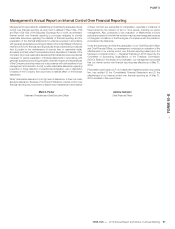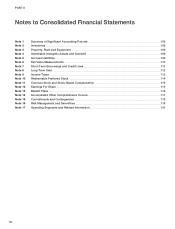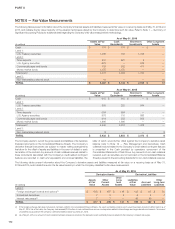Nike 2016 Annual Report Download - page 53
Download and view the complete annual report
Please find page 53 of the 2016 Nike annual report below. You can navigate through the pages in the report by either clicking on the pages listed below, or by using the keyword search tool below to find specific information within the annual report.PART II
Total advertising and promotion expenses were $3,278 million, $3,213 million
and $3,031 million for the years ended May 31, 2016, 2015 and 2014,
respectively. Prepaid advertising and promotion expenses totaled $540
million and $455 million at May 31, 2016 and 2015, respectively, and were
recorded in Prepaid expenses and other current assets and Deferred income
taxes and other assets depending on the period to which the prepayment
applies.
Cash and Equivalents
Cash and equivalents represent cash and short-term, highly liquid
investments, including commercial paper, U.S. Treasury, U.S. Agency,
money market funds, time deposits and corporate debt securities with
maturities of 90 days or less at the date of purchase.
Short-Term Investments
Short-term investments consist of highly liquid investments, including
commercial paper, U.S. Treasury, U.S. Agency, time deposits and corporate
debt securities, with maturities over 90 days at the date of purchase. Debt
securities that the Company has the ability and positive intent to hold to
maturity are carried at amortized cost. At May 31, 2016 and 2015, the
Company did not hold any short-term investments that were classified as
trading or held-to-maturity.
At May 31, 2016 and 2015, Short-term investments consisted of available-
for-sale securities. Available-for-sale securities are recorded at fair value with
unrealized gains and losses reported, net of tax, in Accumulated other
comprehensive income, unless unrealized losses are determined to be other
than temporary. Realized gains and losses on the sale of securities are
determined by specific identification. The Company considers all available-
for-sale securities, including those with maturity dates beyond 12 months, as
available to support current operational liquidity needs and therefore classifies
all securities with maturity dates beyond 90 days at the date of purchase as
current assets within Short-term investments on the Consolidated Balance
Sheets.
Refer to Note 6 — Fair Value Measurements for more information on the
Company’s short-term investments.
Allowance for Uncollectible Accounts
Receivable
Accounts receivable, net consist primarily of amounts receivable from
customers. The Company makes ongoing estimates relating to the
collectability of its accounts receivable and maintains an allowance for
estimated losses resulting from the inability of its customers to make required
payments. In determining the amount of the allowance, the Company
considers historical levels of credit losses and makes judgments about the
creditworthiness of significant customers based on ongoing credit
evaluations. Accounts receivable with anticipated collection dates greater
than 12 months from the balance sheet date and related allowances are
considered non-current and recorded in Deferred income taxes and other
assets. The allowance for uncollectible accounts receivable was $43 million
and $78 million at May 31, 2016 and 2015, respectively, of which $17 million
and $24 million, respectively, was classified as long-term and recorded in
Deferred income taxes and other assets.
Inventory Valuation
Inventories are stated at lower of cost or market and valued on either an
average or specific identification cost basis. For inventories in transit that
represent direct shipments to customers, the related inventory and cost of
sales are recognized on a specific identification basis. Inventory costs
primarily consist of product cost from the Company’s suppliers, as well as
inbound freight, import duties, taxes, insurance and logistics and other
handling fees.
Property, Plant and Equipment and
Depreciation
Property, plant and equipment are recorded at cost. Depreciation is
determined on a straight-line basis for buildings and leasehold improvements
over 2 to 40 years and for machinery and equipment over 2 to 15 years.
Depreciation and amortization of assets used in manufacturing, warehousing
and product distribution are recorded in Cost of sales. Depreciation and
amortization of other assets are recorded in Operating overhead expense.
Software Development Costs
Internal Use Software: Expenditures for major software purchases and
software developed for internal use are capitalized and amortized over a 2 to
10 year period on a straight-line basis. The Company’s policy provides for the
capitalization of external direct costs of materials and services associated with
developing or obtaining internal use computer software. In addition, the
Company also capitalizes certain payroll and payroll-related costs for
employees who are directly associated with internal use computer software
projects. The amount of capitalizable payroll costs with respect to these
employees is limited to the time directly spent on such projects. Costs
associated with preliminary project stage activities, training, maintenance and
all other post-implementation stage activities are expensed as incurred.
Computer Software to be Sold, Leased or Otherwise Marketed: Development
costs of computer software to be sold, leased or otherwise marketed as an
integral part of a product are subject to capitalization beginning when a
product’s technological feasibility has been established and ending when a
product is available for general release to customers. In most instances, the
Company’s products are released soon after technological feasibility has
been established. Therefore, software development costs incurred
subsequent to achievement of technological feasibility are usually not
significant, and generally most software development costs have been
expensed as incurred.
Impairment of Long-Lived Assets
The Company reviews the carrying value of long-lived assets or asset groups
to be used in operations whenever events or changes in circumstances
indicate that the carrying amount of the assets might not be recoverable.
Factors that would necessitate an impairment assessment include a
significant adverse change in the extent or manner in which an asset is used,
a significant adverse change in legal factors or the business climate that could
affect the value of the asset or a significant decline in the observable market
value of an asset, among others. If such facts indicate a potential impairment,
the Company would assess the recoverability of an asset group by
determining if the carrying value of the asset group exceeds the sum of the
projected undiscounted cash flows expected to result from the use and
eventual disposition of the assets over the remaining economic life of the
primary asset in the asset group. If the recoverability test indicates that the
carrying value of the asset group is not recoverable, the Company will
estimate the fair value of the asset group using appropriate valuation
methodologies, which would typically include an estimate of discounted cash
flows. Any impairment would be measured as the difference between the
asset group’s carrying amount and its estimated fair value.
Goodwill and Indefinite-Lived Intangible Assets
The Company performs annual impairment tests on goodwill and intangible
assets with indefinite lives in the fourth quarter of each fiscal year or when
events occur or circumstances change that would, more likely than not,
reduce the fair value of a reporting unit or an intangible asset with an indefinite
life below its carrying value. Events or changes in circumstances that may
trigger interim impairment reviews include significant changes in business
climate, operating results, planned investments in the reporting unit, planned
divestitures or an expectation that the carrying amount may not be
recoverable, among other factors. The Company may first assess qualitative
106
























